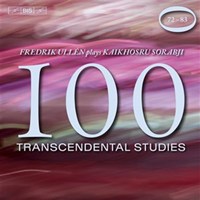100 Transcendental Studies, Nos. 72–83
Fredrik Ullén (piano)
BIS Records: BIS-CD-2223 (2016)
Web page for BIS RecordsWeb page for BIS Records BIS-CD-2223
 Duration: 79:25
Comments: The fifth volume of Ullén’s complete survey of the 100 Transcendental Studies. This CD contains studies 72–83.
Duration: 79:25
Comments: The fifth volume of Ullén’s complete survey of the 100 Transcendental Studies. This CD contains studies 72–83.See Fredrik Ullén’s list of comments on most of Sorabji’s 100 Études transcendantes and a summary table of all known first performances of individual études.
Track listing
- Track 1: 100 Transcendental Studies 72. Canonica (2:11)
- Track 2: 100 Transcendental Studies 73. Quasi preludio corale: Sonorità piena morbida e dolcissima (17:57)
- Track 3: 100 Transcendental Studies 74. Ostinato - Secco - Fantasticamente grottesco (4:22)
- Track 4: 100 Transcendental Studies 75. Passacaglia: Largo (28:50)
- Track 5: 100 Transcendental Studies 76. Imitationes: Presto assai (1:10)
- Track 6: 100 Transcendental Studies 77. Mouvement semblable et perpétuel: Scorrevole (1:34)
- Track 7: 100 Transcendental Studies 78. Leggiero e veloce (1:44)
- Track 8: 100 Transcendental Studies 79. The inlaid line: Legatissimo la linea melodica (2:08)
- Track 9: 100 Transcendental Studies 80. La linea melodica: Mormorando sordamente (5:46)
- Track 10: 100 Transcendental Studies 81. The suspensions: Lento quasi adagio e gravemente solenne (5:35)
- Track 11: 100 Transcendental Studies 82. Sordamente e oscuramente minaccioso (2:28)
- Track 12: 100 Transcendental Studies 83. Arpeggiated fourths (4:12)
Reviews
- “Volume 5 in this essential series for Sorabji enthusiasts continues to demonstrate the limitless pianistic imagination of this utterly sui generis composer. By this stage in his huge cycle of ‘studies’, Sorabji had long since exhausted the constraining parameters set by studies in such-and-such intervals, textures or virtuoso mécanique, and was punctuating the series with large-scale genre pieces in his favourite forms, of which we find two here, both fine specimens of their type. The first is a distinguished chorale prelude, beginning in stately sobriety but accumulating contrapuntal complexity and density of texture and culminating, as was the composers wont in such movements, in the imposing splendour of organo pieno sonority. The other is an even larger, and more impressive, example of Sorabji’s oft-revisited passacaglia form. Half an hour, ten-squared variations, the piece decorates its economical ground bass with the customary extravagant generosity of Sorabjian figuration of every kind, the tension and texture ebbing and flowing in exquisitely judged proportions before the final apocalyptic onslaught of cataclysmic variations not unlike that that concludes the similar movement in Opus Clavicembalisticum. After this monolith, Sorabji returns to writing ‘studies’ of a sort, but now in advanced Sorabjian figurations, as if to say ‘if you’re going to presume to play my music you had better be entirely fluent in these techniques!’ And there are a handful of short character pieces — a grotesque scherzo-like ostinato, a hair-raisingly aggressive toccata-like piece, and so on.” (Records International)
